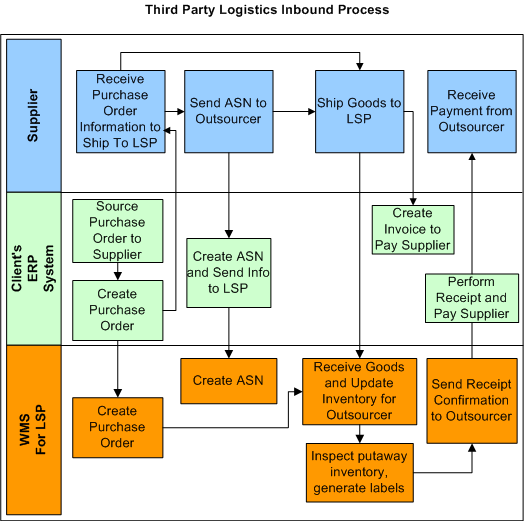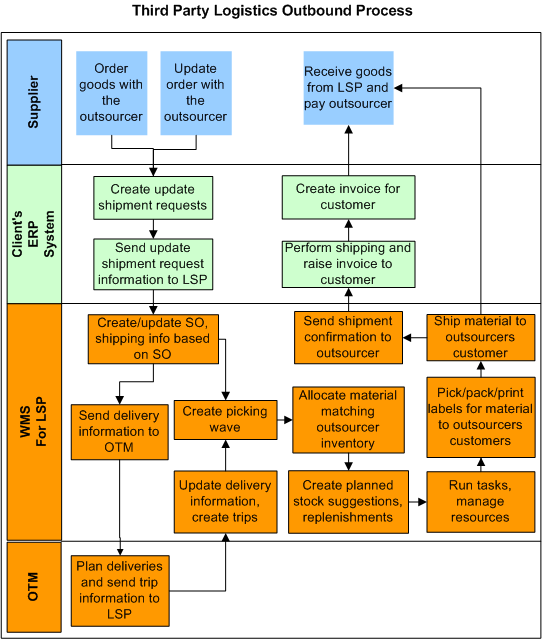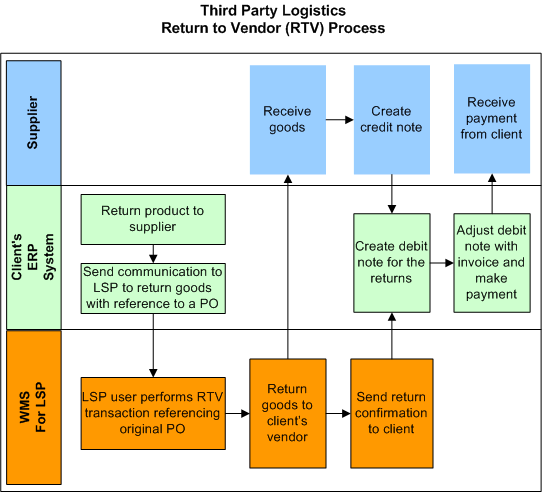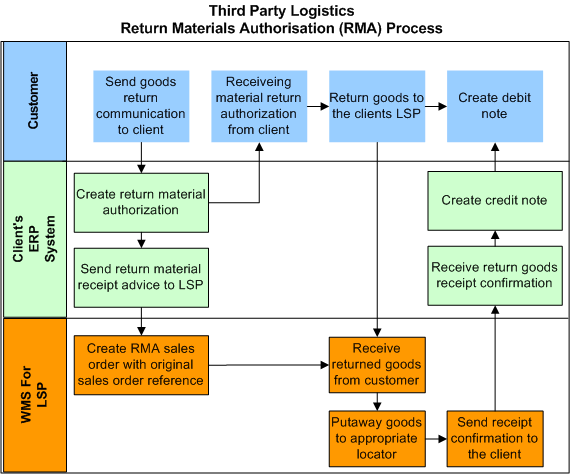Logistic service providers management is the outsourcing of logistics operations to a third party. Companies, or clients, use these third parties known as logistics service providers (LSPs) to provide logistics services. LSPs may provide logistic services to one or more clients at any given time. Clients may choose to outsource a portion, or all of their logistics services to one or more LSPs. When sending information to an LSP, the client communicates the receipts or shipment to the LSP, which then runs the transaction on behalf of the client. Therefore, the client may be a buyer or seller for a transaction.
A client typically outsources the following services to an LSP:
- Warehousing
- Inventory management
- Cross docking
- Transportation
- Freight forwarding
Setting Up Logistics Service Provider Services
For information on setting up logistics service provider (LSP) services and defining client parameters, see Oracle Inventory Implementation Manual, Setting Up Logistics Service Provider Services.
Multi-Tenancy within a Warehouse
Multi-tenant warehousing refers to an arrangement where an LSP provides third party logistics (3PL) services to more than one client at a time within the same warehouse. When LSPs engage in multi-tenant warehousing, they must be able to differentiate between each client’s material, and support the same purchase order number, sales order number, and item number of different clients in the same warehouse.
Example of LSP Services and Multi-Tenancy
The following example illustrates the services provided by a logistics service provider. Warehouse Corp. Inc is a third party logistics company that provides warehousing services to multiple clients. ABC Stores Inc and Jmart Corporation are two clients that enter into an agreement with Warehouse Corp. for logistics support. ABC Stores and Jmart procure material from their suppliers. Warehouse Corp. receives the material and stores it in its facilities. Finally, ABC Stores and Jmart send delivery information to Warehouse Corp., and Warehouse Corp. picks, packs, and ships the desired material to the final destination specified in the delivery details by respective clients.
Inbound Flow
In a typical third party logistics (3PL) scenario, clients synchronize the master data such as items and UOMs with the LSP before the inbound and outbound outsourcing activities begin. In the inbound process, the client communicates the purchase order (PO) information to the LSP, which provides advanced communication about the supplies to receive. The LSP creates a client purchase order reference, and when the material arrives, the receiving clerk receives the material with reference to the client’s purchase order and item information. On completion of receipt, the LSP sends a receipt confirmation to the client which signals to the client to proceed with the supplier invoicing process. The following diagram depicts the 3PL inbound process:

Outbound Flow
Similarly for the outbound flow, the client sends the shipment request to the LSP to ship the material to its customer. The LSP performs the picking, packing, and shipment transactions and sends a shipment confirmation to the client. Note that all of the outbound documents such as the packing slip and bill of lading have client-specific information. The client updates the inventory in its system and raises an invoice to bill the customer. The following diagram depicts the third party logistics (3PL) outbound process.

Returns Process
Logistics service providers can also perform returns for their clients by either returning material to suppliers or handling customer returns. In the return to supplier process, the LSP notifies the client of the need to return goods to a supplier. The client sends a return request to the LSP and requests the LSP to return the goods to supplier.
When returning the goods to the supplier, the LSP references the client’s purchase order. The LSP performs a return-to-vendor (RTV) transaction and returns the material to the client’s supplier based on the return request and sends the return confirmation to the client. The client receives the return confirmation from the LSP and a material receipt confirmation and credit note information from the supplier. The client then creates a debit note, which will be adjusted in the future payments.
The following diagram depicts the third party logistics RTV process:

Customer Returns Process
The customer returns process is similar to the return to vendor process:
- The client’s customer advises the client about returning the goods due to poor quality or rework.
- The client asks the customer to return the goods to the LSP, and at the same time sends a shipment return request to the LSP.
- The LSP receives the communication and creates the RMA sales order.
- The customer sends the material to the LSP.
- The LSP then receives the material and sends the confirmation to the client.
- The client receives the communication and creates the credit note and sends it to the customer.
- The debit note is registered in the customer’s system to adjust against future payments.
The following diagram shows the third party logistics RMA process:

Overview of Third Party Logistics (3PL) Billing
Logistics service providers provide logistic services for clients and bill them periodically for services rendered. An LSP may handle the logistics services for one or more client at any given time. The LSP establishes an agreement with an individual client for the warehousing, services provided, rates, and billing frequency. Third-party billing for LSPs within Oracle Warehouse Management enables you to bill by activity. It uses service contracts, pricing of logistics services, and activity data in WMS to produce an itemized bill based on the actual services an LSP performs on behalf of its clients. WMS provides billing sources for common logistics services such as receiving, put away, storage, staging and shipping of goods. It also enables you to identify your own billing sources such as sweeping and processing of hazmat (hazardous) material.
The following diagram shows an overview of the third party logistics service agreement and billing flow:
